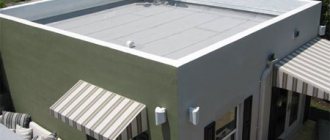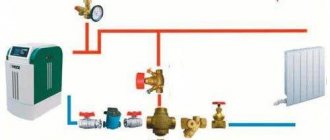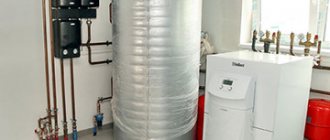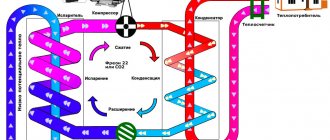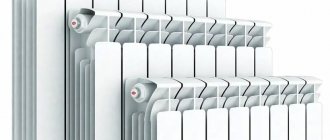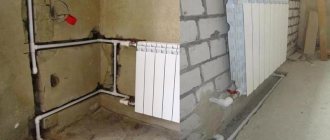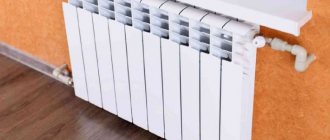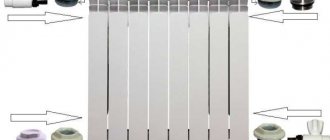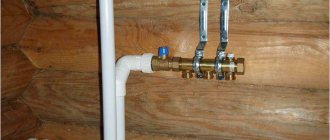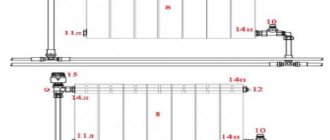Metal mounting
At a time when you need to assemble a new water supply instead of a dilapidated one, you need to connect the metal to the new pipes.
Sometimes it is polypropylene, sometimes it is steel. What needs to be done in order to carry out the installation correctly? First, you need to turn off all the risers to be replaced and drain the water from them. After this, you need to unscrew the old valves, which are still made of cast iron and are very unreliable. They change to more modern ball ones with a flag. Later, using a plumbing cable, a section of the water supply system is cleared of debris (various deposits and rust). The valve itself (new) and the filter are mounted - it is needed to extend the life of the faucet or bathroom equipment, for example, a washing machine. For sealed seams, linen thread is used, which is wrapped around the thread as the nut rotates. At the end of the filter, the required fitting of the appropriate size is installed, and a polypropylene coupling is attached to its other end. After this, the new pipeline is entirely planned.
Radiator piping
The sectional radiator itself is a “semi-finished product” that cannot be connected to the system. Especially considering that it has a right-hand thread on one side and a left-hand thread on the other. This feature is dictated by the way individual sections are connected into a battery through a nipple, which has two sections with multidirectional threads and a gasket between them.
To connect the battery to the system, you need special fittings (futures) and plugs.
The minimum set of additional elements for connecting a cast iron battery includes two fittings and two plugs. Depending on the characteristics of the heating system and the side from which the connections are fitted, the external thread of the plugs and fittings can be left-handed or right-handed. And the internal thread of footwear is always right-handed.
If a cast-iron battery needs to be equipped with a Mayevsky valve or an automatic radiator air vent, then instead of the top plug, another fitting is screwed in.
For aluminum and bimetallic radiators, they sell ready-made kits that consist of four fittings (in pairs with left and right external threads), one plug to match the size of the internal thread of the fitting and one Mayevsky tap (plus a key for it).
Of course, a Mayevsky tap or an automatic air vent is optional, but they make it possible to release the air lock that has formed in the battery.
Another recommended piping element for the central heating system battery is ball valves for supply and return. They make it possible to repair or replace the battery without stopping the system if a leak appears in it, as well as increase the number of sections if there is insufficient thermal power to heat the room.
For an autonomous heating system, instead of a ball valve for the supply, it is better to install a manual or automatic thermostat.
Taps and thermostats are connected to the battery through an “American” connection, and the method of connecting them to the supply line depends on the material of the pipes.
Areas of application
A fitting - what is it: externally, a fitting resembles a piece of pipe or a bolt, along the longitudinal axis of which there is a threaded hole. The external thread is larger and is intended for parts of larger diameter, and the internal thread is smaller and is intended to connect an element of a smaller diameter. Essentially, this is an adapter from one thread to another.
The main function of such a connector is to ensure the connection of two parts with different thread sizes. Often, an element with a broken thread is drilled out to a larger diameter; a plumbing or repair fitting with an internal cross-section corresponding to the damaged part is used to connect it.
The use of threaded fittings is in demand in the following areas:
- Plumbing. Used for connecting pipes, plumbing fixtures, radiators with different standard sizes and materials for manufacturing parts (cast iron, bimetallic, aluminum elements). Most used area.
- Furniture manufacture. Used as a nut for fastening various parts, for recessing fittings into the material. Furniture fittings made of metal or plastic without a hex head for an open-end or socket wrench are mounted using a flat-head screwdriver in the appropriate sockets, for example, in blind holes of a smaller diameter. Some fittings are equipped with a ball that expands the chipboard or MDF when the connecting part is screwed in and secures the fitting tightly in the socket.
- Equipment repair. Often used to connect parts with broken threads. For example, to restore spark plugs in a car. They can be made in the form of a spiral repair insert. For each type of technical equipment, there are corresponding repair kits with restoration devices for the most problematic threaded connections.
Consumers appreciated the high reliability and simple design of this adapter. Their use is limited only by the difficulty of finding some types and sizes of fittings in the nearest store. But if there is no suitable radiator fitting in one store, then in another you can definitely find the necessary fitting.
Types of fittings
Fitin products are classified depending on the configuration:
- Adapter. Allows you to bring the pipeline system to modern standards. The adapter is easy to install and dismantle and can be used repeatedly.
- Barrel. Equipped with threads on the outside.
- Water socket. Used when connecting a tap or mixer.
- Knee. Used for drainage of sewage in horizontal or vertical direction.
- Plug (stopper). Allows you to shut off the pipeline at the right time, ensuring the tightness of the pipeline.
- Collector. Necessary for uniform supply of water from the water supply channel to plumbing fixtures.
- Straight coupling or fitting. Corresponds to the material and design of the pipes connected with it.
- Compensator. This is a curved loop that protects the pipeline from strong pressures of the working fluid and its temperature fluctuations.
- Cross. Used to connect four pipes located at right angles.
- Retraction. Allows you to change the direction of the pipeline by a given angle.
- Pipe branch. Secures the end of the pipe with shut-off valves.
- Revision. Used to provide access to the inside of the pipe in order to eliminate blockages that occur in it.
- Connecting press. Necessary for connecting threaded pipes.
- Demountable connection. Joins pipes of different types.
- Sgon. Used to connect plumbing fixtures and fittings.
- Siphon. Connects plumbing points to sewer outlets.
- Tee. Allows you to fix three pipes at one point.
- Extension.
- Flange. Necessary for connecting the pipeline with other structures.
- Futorka. Has external and internal threads.
- Union. Required for connection to a flexible hose.
Fittings are made of stainless steel, bronze, cast iron, brass, metal-plastic, polyethylene. In rare cases, copper may be used.
Siphon (Photo: Instagram / metallplast)
Rules for choosing the diameter of heating pipes
The cross-sectional size affects the circulation rate of the coolant. If the diameter is chosen incorrectly, the transportation of the heated liquid will be slow, and the devices will heat up unevenly. Coolant fluid flow speed standards are 0.4–0.6 m/sec. Reducing movement to 0.2 m/sec. causes water stagnation and air pockets form. Provided the coolant circulates at a speed of 0.7 m/sec. Energy consumption increases and noise is heard. The optimal parameter for the speed of water movement in the system is 0.3–0.7 m/sec. From this calculation, the diameter of the heating pipe is selected.
Recommendations from experts on product selection:
- if no more than 2 radiators are connected in the network, the cross-sectional size is up to 16 mm;
- when integrating 1 battery with a capacity of 7 kW or several radiators with a capacity of up to 2 kW (in total, the total power should not exceed 7 kW) - the permissible circuit cross-section is 20 mm;
- with a total power of a group of radiators in the main line of 11 kW, a pipe with a diameter of 25 mm is needed;
- supplying heat to a dead-end distribution, for example, to a distant wing of a house, requires the installation of elements with a cross-section of 25 mm;
- parts with a diameter of 32 mm are mounted into a network with 12 batteries with a total power rating of up to 19 kW;
- if the house system has more than 20 radiators, the total power of which is not higher than 30 kW, products measuring 40 mm will be required.
It is also important to consider the capacity of the pipeline. If the water speed in the main line is no more than 0.4 m/sec, the polypropylene circuit ensures the transfer of the required amount of heat. Table of thermal energy release depending on the pipe cross-section:
Table of thermal energy release depending on the pipe cross-section:
| Thermal energy (kW) | Outer diameter (mm) | Inner diameter (mm) |
| 4,1 | 13,2 | 20 |
| 6,3 | 16,6 | 25 |
| 11,5 | 21,2 | 32 |
| 17 | 26,6 | 40 |
How to choose the right wallpaper depending on the type of room
You need to choose one or another type of wallpaper based on the room in which it will be hung.
For a bedroom, living room or nursery, you can choose any type of wallpaper at your discretion. Unless for the bedroom and nursery it is recommended to choose canvases made from natural materials. Kitchen and bathroom – rooms with high humidity levels
Therefore, when choosing wallpaper, you need to pay attention to moisture-resistant models. Corridor. Outerwear (sometimes after rain) or dirty shoes are often left in the hallway
Dust or dirt from jackets and boots can get onto the wallpaper - so choose a canvas that can be wet cleaned.
Let's take a closer look at which rooms the above materials are suitable for:
| Types of wallpaper | Bedroom | Living room | Children's | Kitchen | Bathroom | Corridor |
| Paper | Allowed | Allowed | Allowed | Not recommended | Forbidden | Not recommended |
| Non-woven | Allowed | Allowed | Allowed | Allowed | Allowed | Allowed |
| Vinyl | Allowed | Allowed | Forbidden | Allowed | Allowed | Allowed |
| Textile | Allowed | Allowed | Allowed | Not recommended | Forbidden | Allowed |
| Glass wallpaper | Allowed | Allowed | Allowed | Allowed | Allowed | Allowed |
| Liquid | Allowed | Allowed | Allowed | Forbidden | Forbidden | Allowed |
| Bamboo | Allowed | Allowed | Allowed | Allowed | Not recommended | Allowed |
| Photo wallpaper | Allowed | Allowed | Allowed | Allowed | Allowed | Allowed |
It is included in the kit
Let's look at what specific elements are included in the complete set and why any of their components is recommended.
Futorki
The following can be said about this element:
- The set of plugs for radiators 3 4 includes 2 fittings with a right-hand thread and two fittings with a left-hand thread , the internal size of which is ? inches, in sets for ? inch thread is correspondingly smaller.
- The external thread size is invariably 1 inch , as this standard is used by all radiator manufacturers.
Note! Many customers do not know why there are 4 footers in the set, since only two are needed. Everything is quite simple: the manufacturer does not know much about the type of connection on your radiators, and the presence of four elements allows you to use any option.
- In order for the connections to be not only strong, but also airtight, they must be further sealed . To do this, it is recommended to use tow and paint, but if you don’t have them on hand, you can also use Unipack tape. It is fundamentally important to eliminate any possibility of leaks.
O-rings
Many people do not pay attention to these elements, but they are extremely important:
- Products can be made from paronite or silicone . Many experts recommend the second option as more reliable and durable.
- It is fundamentally important that the ring is placed evenly and that when tightening the elements it is not pinched too much , since it is possible to simply crush it.
Mayevsky tap and plug
The following can be said about these elements:
- The plug is needed to cover one of the lower terminals, which will not be used for wiring . It is similar to a futorka, but does not have a through hole and looks more like a cork.
- As for the Mayevsky valve, it is a design in which a needle valve is located , with its help it is possible to very quickly remove excess air space from the system. It is fundamentally important that the kit also includes a special key, thanks to which the radiator is vented.
Brackets
The reliability of these elements is important, since the strength of the element’s fastening depends on it. Not every radiator kit includes these products, since not everyone needs them, and their price is high.
If you make the fastening yourself, then consider the following tips:
- For wooden and plasterboard surfaces, elements in the form of corners or special plate holders are required . For brick and cement walls, products in the form of pins and saber-type elements are suitable.
- For concrete and brick, you need to drill holes in the walls and insert dowels into them ; it is fundamentally important to position the brackets at the same level so that the radiator is positioned without distortion.
It is possible to find two options on sale - a set for a radiator 3 4 and 1 2, as noted above, the choice of a specific option depends on the diameter of the pipes, otherwise they are completely similar. The most important thing is the high level of product quality.
How and what to seal pipe joints with
Types of seals, sealing methods
To prevent leakage of the pipeline working fluid, it is necessary to properly seal the pipe twists.
When threading steel pipes, the following are used as seals:
- gasket This method of sealing a threaded connection requires relatively thick end pipe cuts. The presence of smooth pipe ends can never ensure tightness. When using a rubber or plastic gasket, this problem is successfully solved. This option is ideal in case of articulation using a union nut;
- winding The materials can be linen strands, polymer threads, FUM tapes in combination with hardening sealants, paints, pastes.
When installing plastic risers, a sealing method is used based on the deformation properties of the material. The essence of this method is that a plastic pipe with an external thread is screwed into a riser with an internal thread. During deformation, plastic contributes to excellent filling of the intermediate space, eliminating the appearance of gaps.
When it comes to pipeline structures with high pressure, cylindrical threaded pipe connections are not entirely appropriate here. In such cases, a conical type connection is used. The principle of connection is that when screwing in, the pipes are tightly pressed until the gap completely disappears.
Materials for sealing joints
To make the joint impenetrable, the following are used as seals:
- flax (tow);
- asbestos;
- FUM tape;
- natural drying oil;
- whitewash;
- minium;
- graphite lubricant, etc.
A reliable sealant when twisting steel pipes onto threads is strands of flax impregnated with red lead or white lead. This connection is easy to install and reliable in terms of sealing. The seal has been used for a very long time and does not lose its popularity today, despite the emergence of artificial analogues.
For those who have little experience in installing fittings and pipes, we suggest that under no circumstances use flax without paint.
At first, the joint will not allow moisture to pass through. But several months will pass, the flax fibers will get wet and begin to decompose. Therefore, the quality of all connections will deteriorate, and in another month or two, water will leak at the junction.
Many people use FUM tape, which is in no way inferior to old traditional materials - tow with paint.
Sometimes there is no tightness at the junction of the risers. To eliminate this defect, you need to replace the sealing material, and clean the threaded area from dirt and sealant residues. After this, rewind the linen thread, FUM tape or other sealant, and assemble the structure.
Pastes and sealants of chemical origin are used as additional sealants, which will help strengthen this section of the pipeline.
Application in the furniture industry
No matter how strange it may seem, footwear can also be used in this area. Wide demand in the furniture industry is due to its special design. Since the futorka is a connecting element, which is a threaded part in the form of a bushing with an internal thread, it is most often used as a base for hooks (when installing furniture shelves in wardrobes). In addition, the futorka retains its properties (strength) very well on chipboard panels. That is, in order to ensure reliable fastening, craftsmen first have to drill a hole for the footing, and only then place the hook and shelf on it.
What is futorka
The fitting is a specially designed adapter, which is characterized by both external and internal threads.
Very often their diameter differs significantly. In the language of plumbers, they have their own “names”.
So, the internal thread is usually called a nut, but the external thread is called a fitting. There are also pipe and metric threads.
Each product can have its own thread diameter. This indicator is measured in inches or millimeters. The tool with which you can make such calculations is a caliper or ruler.
The accuracy of measurements in this matter is quite important. Even one inch of threaded connection mismatch can cause problems with the normal functioning of the heating or plumbing system.
Based on the purpose and fittings used, the fittings are divided into two groups: those used for cast iron products and for adapters for bimetallic and aluminum objects.
First class characteristics include:
- Products designed for connecting cast iron batteries to pipelines and shut-off valves. The guiding factor is the design of the heating system itself.
- Cast iron parts. Despite their low cost and lack of external coating, they have earned their place due to their high level of reliability.
- Brass elements. Due to its ability to tightly adhere to a cast iron product, it is not so popular among consumers. This type of product has a slightly higher price and is not reusable.
- Thread direction. The radiator can be connected from different sides - right or left. The direction of twist at the foot will also change.
- Possibility for better clamping when using various devices. Frequently used tools are open-end wrenches, plumbing wrenches and socket wrenches.
- Products are characterized by a certain number of characteristics, namely maximum pressure, temperature, type of working environment. The adapter can operate using steam, air, oil, gas and water. The pressure can reach 25 Bar, the maximum temperature will be 300 degrees. Based on these indicators, not every material is able to cope with its work in such conditions.
Technician's note: it is not recommended to use FUM tape to seal the threads of the radiator liner. This is due to the fact that it does not tolerate high temperatures well. The best option would be the classic type using flax.
The second group of products, namely adapters for aluminum and bimetal, include the following characteristics:
- Such parts are often made of high-strength galvanized steel. This material provides a high level of reliability, as well as resistance to corrosive processes.
- Coating of the element with epoxy powder enamel. It gives the product strength, resistance to deformation, and attractiveness.
- There are also left-hand and right-hand threads.
- In order not to compromise the integrity of the components, a special key is used during the installation process to tighten them. It will help to secure the connections well when assembling the system, and also not to damage the surface of the pipes.
- Operating pressure. The maximum value of this indicator in the system is 16 Bar, and the coolant temperature is 110 degrees.
- Paronite or silicone rings are best suited for sealing joints. Their effectiveness is due to their good resistance to high temperatures, as well as their ability to be elastic for a long time.
- To ensure the comfort of customers, manufacturers produce ready-made kits, which include 4 fittings and gaskets, one plug and tap, and a key.
There may also be adapters with a flange, which in essence are also a futor. The internal thread of such conductors is always larger than the external one.
What is a futorka and what does it do?
The author of the question thinks this answer is the best
A fitting is primarily a threaded fitting. And it does this by switching from an internal thread of a larger diameter to an internal thread of a smaller diameter.
1 Good answer
What is a cutter?
The word “cutter” itself comes from the English “cut” - to cut. It is a machine much like a blender, the main task of which is to finely grind meat and other ingredients. The scope of application of such a technical innovation is very wide. In industry, the cutter is used in the production of smoked, boiled and liver sausages, frankfurters, sausages, cutlets and other semi-finished products, minced meat and pates.
At home or in a restaurant kitchen, the cutter will become an indispensable assistant in preparing sauces, cream soups, dough, jams, berry mousses, omelettes and much more.
1 Good answer
What is mutabor?
The form of the verb is in the first person, singular, future tense, passive voice.
Russian musician and DJ, member of the scandalous hip-hop trio “Malchishnik” and the alternative group “Dubovy Gaai”.
What is the difference between a hole and a hole?
A hole usually involves a recess and is made intentionally, but a hole can also be on clothing (“flat”), and, as a rule, it is not intended to be there. In a certain context, these words can be synonyms
1 Good answer
What is futurism? What is its essence?
Futurism is a literary movement that came to Russia from Italy at the beginning of the 20th century. It did not last long, about 10-15 years. The founder in Russia is considered to be the poet and artist David Burliuk. He was supported by Mayakovsky, Khlebnikov, Kruchenykh and others. The very essence of the phenomenon is to use new forms, spirals, zigzags, speed, fast and dexterous movements in art and new words, professionalisms and jargon, vulgar vocabulary in literature.
From the point of view of literature, the main document of the Futurists is the manifesto “A Slap in the Face of Public Taste,” where the Futurists call for “throwing Dostoevsky, Pushkin, Tolstoy and others off the ship of modernity.”
Source
Problems and solutions
Dripping water and puddles on the floor mean that the integrity of the pipeline has been depressurized at the joints. There are several typical problems and ways to solve them:
- Leaking locknuts at water supply connections. Usually the reason is unsuitable winding.
- Heating radiator lock nut is leaking. Leaks occur due to displacement of the heating battery at the point of connection to the heating line. The problem can be solved by additional winding of the locknut or restoration of the fitting with damaged threads.
- Leakage thread length. This occurs due to too thin pipe walls or destruction of the anti-corrosion coating on the outer surface of the fitting. The defect that has arisen is eliminated by replacing the fitting.
Radiator valves
In any modern apartment or private house, the heating system plays an important role. And today there are a sufficient number of functional devices and solutions that make it much more energy efficient and adjustable. After all, it’s no secret that heating in our homes does not always work as we would like.
In this material we will look at why control valves for heating radiators are needed and how they will help improve the heating of a house or apartment.
So, radiator valves (valves) are a type of pipeline shut-off and control valves. And they are designed to regulate (control) the coolant flow in the radiator in manual mode. Depending on the design, straight and angular ones are distinguished. Most often they are made from brass or bronze. As a rule, valves are distinguished by their low price, tightness and often stylish design.
Unlike conventional ball valves (shut-off type), a manual regulating valve for radiators allows you to more smoothly change the amount of coolant, i.e. liquids into batteries. This means that at any time you can adjust the temperature in the room as you wish. For example, if the room is already warm, then the heating is clearly excessive, then using a valve you can reduce the heat transfer from the radiator. But it is worth remembering that an angle valve for a radiator can only reduce the heat transfer of the battery!
Main varieties
Plumbing fittings, in turn, are divided into two groups.
Adapters of the first group are used for installation in cast iron pipelines, heating radiators or plumbing fixtures. Their advantages:
- relatively low price;
- withstand pressure up to 25 Bar and temperature up to 300 °C;
- possibility of contact with hot water, steam, oil;
- availability of parts with right and left threads.
Fittings of the second group are intended for aluminum or bimetallic connections. Usually made of galvanized steel and have the following advantages:
- corrosion resistance;
- withstand pressure up to 16 Bar and temperature up to 110 °C;
- installed with special tools that do not damage the pipeline or radiator;
- the presence of a special powder enamel coating.
Futorki differ in purpose, depending on the scope of use: plumbing, furniture and repair .
The material from which the adapter is made also depends on the area of use and the amount of load it will experience. Main materials of manufacture:
- cast iron;
- Cink Steel;
- brass;
- aluminum;
- plastic.
It is impossible to compile an exhaustive list of all types of these fittings, since they are produced by individual manufacturers for certain units or parts. However, all adapters are produced in accordance with technical standards and GOST requirements, so that a part, for example, with a cross-section of ½ or ¼, exactly matches the thread of a pipe or radiator.
Pros and cons of aluminum heaters
Aluminum radiators have become frequent “guests” of private houses and apartments in houses with centralized heating.
This was made possible thanks to the qualities that have won the hearts of consumers around the world:
- Aluminum is one of the best heat conductors. releasing it into the surrounding space in two ways: radiation and thermal convection. This feature is especially in demand in heating systems with unstable media pressure.
- Assembly of aluminum radiator sections is possible without the use of additional forces. Since their light weight allows you to do everything yourself. They are easy to both transport and install.
- These batteries can withstand pressure from 16 to 25 atmospheres. which makes them desirable in the places that were occupied by cast iron “accordions”. There are 2 types of aluminum radiators. One of them is suitable for autonomous heating systems, where the load rarely exceeds 10 atmospheres. The second is for batteries connected to central heating, where differences of up to 15 atmospheres occur.
- Aluminum radiators are much lower in price than their steel or bimetallic counterparts. This is one of the most important factors that attracts consumers.
- They are easily adjustable. which allows you to create the necessary microclimate in the room and save money on heating.
- They have an attractive design. which easily fits into any interior.
These qualities have made aluminum batteries in demand all over the world, despite the fact that they have minor disadvantages:
- Aluminum is not resistant to corrosion, but modern radiators are treated with special means that prevent its occurrence. But even after treatment, it is better to keep such heaters filled with coolant, which is difficult to do in a centralized heating system, where water is discharged after each end of the season. This is why aluminum batteries are more in demand in autonomous systems where there are no such discharges.
- Batteries of this type are prone to air condensation. therefore, at the beginning of the heating season, excess air must be vented from them.
- The threaded connection in aluminum models is weak and if there is a strong water hammer, a leak may appear at the joint. This defect can be eliminated only by knowing how to assemble an aluminum heating radiator using additional gaskets.
This type of radiator is available in two types: solid and sectional. The second is most common in private houses and apartments.
Find out useful information about aluminum batteries on our website:
teplomex.ru
When planning and installing a water supply or heating system, installing radiators in private houses or apartments, many of us have probably heard all sorts of terms that are understandable only to plumbers.
For example, pipe bends, assembled pipes, coupling or barrel, fitting or thread, ball valve with American, etc. Let's try to figure out what it is.
Threads and threaded connections
Divided by:
- type - diameter (size) - direction
Types of threaded connections
Everything is simple here. Threads can be pipe or metric. They differ in thread pitch. When installing plumbing and heating systems, pipe threads are mainly used. The connecting pipes of water heaters, boilers, filters, meters and pumps usually have pipe threads.
Metric is found much less frequently, for example, on pressure gauges or gearboxes. Also, the thread can be internal or external. In the language of plumbers, the internal thread is often called a nut, and the external thread is called a fitting.
Diameter of threaded connections
Each device or pipe may have its own thread diameter. The unit of measurement is inch or millimeter. It is important to remember that the diameter of all threaded connections made of metal is usually measured internally.
The diameter of polypropylene pipes and fittings is measured from the outside. For example, if the diameter of a plastic polypropylene pipe is 20 mm, then this is analogous to a metal pipe with a diameter of 15 mm, if 25 mm, then it is 20 mm (3/4), respectively. Fittings made of polypropylene are the same.
Because of this, inexperienced installers and plumbers sometimes get confused. You can take measurements using special measuring tools: a caliper or a ruler. You can determine the diameter simply “by eye,” but this comes with experience.
The photo below shows a table of the main diameters used in plumbing.
Diameter table
Thread direction
Threaded connections with right-hand threads are screwed in or screwed in clockwise, left-hand threads are screwed in counterclockwise. Simply put, if the thread spiral rises to the right, then the thread is right-handed.
When installing water supply systems, as a rule, threaded connections with right-hand pipe threads are used. The left one is used less frequently, but is almost always found when connecting pipes to heating radiators. Heating radiators, as a rule, have left-hand threads on the left side and right-hand threads on the right side.
In order to switch to the right-hand thread and the pipe that we need to connect, we need to purchase a special installation kit for radiators, which includes 4 fittings (two with left-hand threads, and two with right-hand threads), gaskets, a plug and an air bleed valve - tap Mayevsky. Some kits come with wall fasteners.
Futorka what is it
A fitting is an adapter that has internal and external threads, in which the diameter of the external thread is always larger than the internal one. For example, the plumbing term - 1/2 by 3/4 fitting means that the diameter of its internal thread is 1/2 inch, and the external thread is 3/4. The material from which the futor is made is brass or nickel-plated brass. In the case of radiator footings - aluminum or cast iron.
An adapter with a flange is the same as a fitting, only the diameter of the internal thread is always larger than the external one.
A coupling is a pipe threaded adapter that has only internal threads. It can be made of brass, steel or cast iron. The thread diameter at the ends may be equal or different.
A barrel or nipple is a pipe threaded adapter that has only male threads at both ends. The barrel material is usually nickel-plated brass or steel. Thread diameter: everything here is the same as with the coupling.
Pipe benders are the same barrel, only having one end with a long thread and the other with a short thread, just like a barrel. The standard length of the pipe run is 110 mm. Less common with longer lengths. The material can be either steel or brass. The diameter at the ends is equal.
In the photo (from left to right): a sleeve, a barrel, a coupling, a squeegee, an adapter with a flange, a lock nut.
The assembled squeegee is a threaded detachable connection consisting of the squeegee itself, a coupling screwed onto it and a tightening locknut. Used as a detachable element of a pipeline.
An American ball valve is a valve that opens and closes the flow of water using a steel ball built into it. The American one is a union nut with a fitting; by unscrewing this nut, the valve is disassembled in half.
Often used when connecting heating radiators. By turning off the taps and unscrewing the union nuts, you can easily dismantle the battery, for example, if there is a leak or moving the radiator to another place in the room. It is practical for shutting off water in the pipeline, but not very convenient for adjusting the temperature of the heating system; for this purpose it is better to install a valve with smooth adjustment.
So, in this article we told you about the main elements of the pipeline and types of connections. The article is informative in nature, and it is better to entrust the installation of the pipeline and connection of heating and water supply devices to professionals. Let's watch the video.
Pipeline assembly technology
To assemble the pipeline, you must perform the following sequence of actions:
- First, screw the coupling onto the pipe.
- Then the side with the short thread is screwed into the coupling (sometimes it is connected directly). The parts should be screwed all the way, then the connection will be reliable.
- A locknut is screwed onto the long side of the drive.
- Next comes the connecting fitting.
- Then the end of the drive is applied to the pipe and the coupling is screwed together so that it goes onto the pipe. The connection will be easier to complete if the axes of the parts coincide as much as possible.
- The fitting must then be secured with a locknut. To do this, it should be screwed to the coupling so that there is a distance of 2-3 cm between the parts. This space must be filled with strands of flax. They should be wound in the direction of rotation of the nut. Then the locknut should be tightened until it stops. This must be done to seal the connection and prevent water leakage through it. You should use a wrench to tighten the locknut because its edges are narrow.
Types of couplings depending on the type of connection
In this case, what is meant is that all adapters, despite the fact that they perform the same function, their method of fixation may be different. Let's look at everything in detail in the table below.
| Mounting method: | Highlights: |
| This is essentially the soldering of elements and this technology is used for plastic systems. The advantage of this method is that the connection is very tight and reliable. If the master does everything as expected, then under no circumstances will any leaks appear at the joints. As for the shortcomings, it is possible to single out such a moment as incorrect soldering. If the melting temperature of the plastic is exceeded by at least a couple of seconds, then after installation of the fitting is completed, the possibility of cracks appearing is enormous. Well, what if the soldering iron affects the part less than necessary, then the strength of the connection will be low. |
| Well, everything is quite clear here - the fitting is made of metal, in most cases. The part is simply screwed onto the end of the iron pipe. The advantage of technology is the low price of similar work and its simplicity. It is completely possible to do everything yourself without involving experts and without purchasing expensive tools. Well, the disadvantages of the method are that such seams will have to be constantly monitored, since there is a huge risk of their depressurization. Based on this, a threaded pipe coupling should never be embedded inside a wall, for example. |
| For the most part, it is used to connect lines through which water or some air currents pass. The essence of the connection is that the connector is snapped onto the ends of the pipes using special carbine-type nuts. Such a seam can be made quickly, but its tightness and strength are not very good. |
| The principle of operation is that the pipe is, as it were, put on a special pipe in the connector. The fitting itself, in most cases, has a nut that clamps and fixes the coupling on the pipe. These connectors can withstand enormous pressure, you just need to ensure that there is a high-quality coupling for the pipe - the metal hose, by the way, and the pipe itself must also be strong . |
The couplings may contain rubber seals, which are very sensitive to temperature changes. If the rubber in the product is of poor quality, then as the temperature changes, an increasing number of microcracks will slowly appear on it. And this, of course, will affect (in a bad way) the tightness of the connection of the pipeline elements.
As for the scope of application of couplings, they are now actively used to connect the following systems:
- For water pipes.
- For gas lines.
- For heating mains.
- For oil pipelines, etc.
Of course, in a private house or apartment, fittings are much more often used to connect heating pipes or water supply/drainage
Let's look at how such parts are mounted in most cases and what is fundamentally important to take into account
How to choose the best option
Firstly, you need to know what diameter of pipes will be used; for thin-tube options, use a set for a radiator 1 2; for pipes with a diameter of 16-20 mm, use option ?.
Secondly, when purchasing, you need to pay attention to a number of parameters:
| Coating quality level | Much more often, products are coated with white powder paint, which should be uniform and monochromatic, without poorly painted areas. High-quality products are always processed well, and defects in this type of processing much more often indicate that this is a budget option, which, most likely, will not differ in reliability and durability |
| Material of manufacture | Never get elements made of powdered metals, since they are so fragile that they can break during installation; they are very easy to distinguish - by the small weight of the elements. The best option is galvanized steel; it combines perfectly with any type of radiator and is characterized by great strength. |
| High quality thread | The reliability of the connections depends on how well the threaded part is made; it should not have flaws or bends. Before purchasing, we recommend checking how easily the elements are screwed, they should be screwed without any resistance |
| Operating pressure | The average indicator of high-quality options is 16 Bar; if the value is lower, then it is better to look for a better option |
Note! When purchasing, it is best to buy products from well-known brands; it is good if the manufacturer of the radiators and components are the same. If the manufacturers are little known, then use all the tips listed above in order to choose the best one.
What specific fittings are there?
The differences between fittings can be determined by several parameters. For example, their size and shape may depend on the following indicators:
- pipe diameter,
- pipe material,
- where they will be used.
Now more details. The diameter of the pipes also affects the diameter (internal or external) of the fittings; therefore, when taking fittings, it is necessary to first determine the size of the pipes with which to work. Otherwise, you will not be able to answer the seller’s question about what diameter fittings are needed. Speaking of diameter, it is meant that both fittings with uniform diameters of outlet holes can be used, when the size of the pipes is the same, and adapters, if you need to connect a large pipe with a smaller one.
When it comes to what material should be used, there are a few things to consider. For example, if threaded types are used, the connection must be sealed with a strand of flax, FUM tape or something similar for greater tightness. When welding, tightness is determined by how carefully the seam is made.
Fittings for flanges are sealed only with rubber gaskets, and when using crimp fittings, O-rings pre-lubricated with sealant are used. In addition, there are mixed fittings (a combined version, where one side is welded to the pipe, and the other has a thread).
Compression fittings are used much more often, because it is thanks to them that reliable tightness is optimally ensured, and welding and threading are not necessary. They are easy to install, they can be removed without any trouble, and the process can be carried out several times.
Sealing the liner on a heating radiator is an issue that is relevant both when installing new equipment and when urgently replacing a connection that has leaked. In order to install the system efficiently and protect your home from flooding for the next 20 years, you need to approach the choice of sealant with all responsibility. Let's see what the plumbing market offers for sealing threaded connections in heating radiators.
What are we compacting?
A fitting or threaded fitting is a connecting element between the battery and heating pipes. It is the futorka, despite its insignificant appearance, that is the key link in the heating system of a house or apartment. The comfort and safety of your home will depend on how you seal the threaded connection with the fitting.
A fitting is a nut or bushing with external and external threads for connecting to pipes of different diameters.
When do we compact?
Typically, footers are sold together with gaskets - rubber, paper, paronite, silicone. In theory, the gaskets should help seal the threads and protect against leaks. In fact, they are practically useless. So, only a professional can make a seal with a silicone gasket. When tightened, this material tends to “come out” of the thread and you have to unscrew and reassemble the connection several times. Rubber gaskets work until the first pressure surge; they often tear and, as a result, allow water to pass through.
Our advice is to get rid of the gaskets that come with the footer and replace them with a stronger “product”. Forewarned is forearmed. Make a connection immediately and forever.
What do we seal with?
To seal the battery casing, materials of different generations are available on the market. Until now, flax is considered the most common. Linen winding is a classic of the genre, and this is the first thing that a plumbing store can recommend to you. But don't rush to be charmed by the low price. The combination with flax tow is a thing of the past. And not only because today the market offers much more civilized tools. The system itself has changed. If earlier the pressure in pipes reached a maximum of 8 atmospheres and connections on flax had nothing to fear, then in modern high-rise buildings when crimping pipes, the pressure reaches 16 atmospheres. Is it possible to talk about protection here? Flax, moreover, requires additional impregnation in the form of paint or a special composition (red lead on drying oil, for example). The paint that held tow tightly in the Soviet years can no longer be found, and red lead is not sold on every corner.
Linen is a natural material that swells, rots and causes corrosion inside the thread. The connection on the tow will have to be changed every 2-3 years.
Another option from the past is fum tape. It’s easier to work with than flax strands, but that’s where all the advantages end. Firstly, fum tape has the ability to tear when winding and crumble when drying. This means that leakage is 100% unavoidable. Secondly, if fum tape is suitable, it is only for cold water supply and discharge systems. This material cannot withstand multidirectional loads, obvious for heating systems. Thirdly, fum tape is capricious and requires the thread to be in perfect condition when winding. This is not only about cleanliness, but also about the design of the foot itself. If the manufacturer applied the notches carelessly, the tape will tear very quickly and will not have time to last even a couple of weeks.
For a long-lasting seal of the battery casing, pay attention to modern sealants - anaerobic gels and plumbing threads. A 20-year leakage guarantee is a serious claim to victory and consumer trust.
Anaerobic gels are a new generation of sealants that are easy to apply, completely fill the threads and form a super-strong connection inside. Suitable for sealing threaded and flanged metal connections in heating systems, including heating antifreeze, water supply, sewerage and even drinking water.
Application technology
If only an experienced craftsman can work with flax and fum tape without any problems, then even the most ordinary consumer, an amateur, can apply an anaerobic sealant and seal the futor. But this is important when it comes to eliminating an unexpected leak.
Anaerobic gels are produced in a convenient tube with a brush. The gel is applied directly from the tube to the thread - a narrow neck is provided for this - and distributed evenly. The viscous gel does not flow or roll off. Then the connection is tightened without any effort, and the excess gel is either removed or transferred with a brush to the next thread. The waiting time for the gel to polymerize will take from 5 to 20 minutes.
It is important that, if necessary, the connection can be dismantled at any time, regardless of when it was assembled. When dismantled, the gel breaks up into fractions of different sizes - from crumbs to small granules. It is enough to remove them, clean the threads and reassemble them.
Anaerobic gel sealants:
• protect threads from corrosion • do not shrink or expand • are resistant to mechanical stress, pressure and temperature changes
Plumbing thread, unlike anaerobic gels, is also suitable for plastic pipes. It starts working instantly, without waiting for polymerization.
Wind the thread crosswise along the thread, starting from the first turn. The layers are made thinner at the edges, thicker in the middle. This is necessary for easy assembly of the connection. The number of turns depends on the diameter of the pipe. The maximum figure is 15 turns for DN 30. Considering the length of the thread is 50 meters, we can safely talk about the economical consumption of material. One coil will last for several years for occasional household work.
Advantages of plumbing pipe winding
• instant sealing • contains no plant components, the product is completely synthetic • can be used on wet and dirty threads • works in the range from -60 to +120 °C
When preparing for the heating season, when replacing a radiator or after fixing a leak, think about choosing a high-quality sealant. Anaerobic gels SantekhMaster Gel and pipe winder Record are guaranteed to last for several decades and protect your apartment or cottage from emergencies and unplanned expensive repairs.
If you need to do this work efficiently and without special expenses, choose modern sealants. You can buy them directly from ]on our website.[/anchor]

